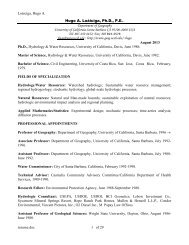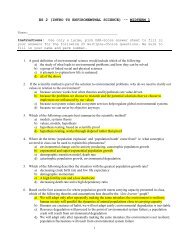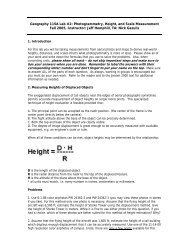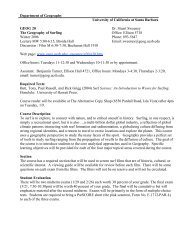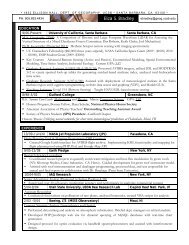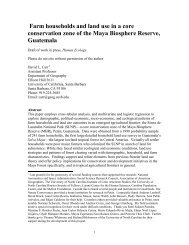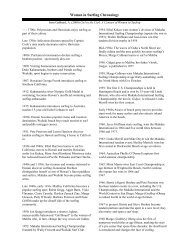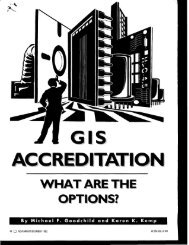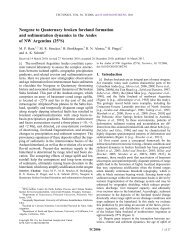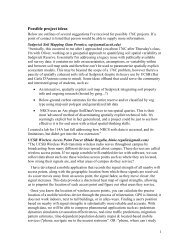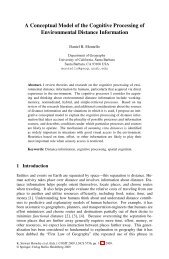Spatial knowledge acquisition from direct experience in the ...
Spatial knowledge acquisition from direct experience in the ...
Spatial knowledge acquisition from direct experience in the ...
Create successful ePaper yourself
Turn your PDF publications into a flip-book with our unique Google optimized e-Paper software.
128 T. Ishikawa, D.R. Montello / Cognitive Psychology 52 (2006) 93–129<br />
Kuipers, B. J., & Levitt, T. S. (1988). Navigation and mapp<strong>in</strong>g <strong>in</strong> large-scale space. AI Magaz<strong>in</strong>e, 9(2), 25–43.<br />
Landau, B., Spelke, E., & Gleitman, H. (1984). <strong>Spatial</strong> <strong>knowledge</strong> <strong>in</strong> a young bl<strong>in</strong>d child. Cognition, 16, 225–260.<br />
Liben, L. S., Patterson, A., & Newcombe, N. (Eds.). (1981). <strong>Spatial</strong> representation and behavior across <strong>the</strong> life span.<br />
New York: Academic Press.<br />
Lloyd, R. (1989). Cognitive maps: Encod<strong>in</strong>g and decod<strong>in</strong>g <strong>in</strong>formation. Annals of <strong>the</strong> Association of American<br />
Geographers, 79, 101–124.<br />
Loomis, J. M., Klatzky, R. L., Golledge, R. G., Cic<strong>in</strong>elli, J. G., Pellegr<strong>in</strong>o, J. W., & Fry, P. A. (1993). Nonvisual<br />
navigation of bl<strong>in</strong>d and sighted: Assessment of path <strong>in</strong>tegration ability. Journal of Experimental Psychology:<br />
General, 122, 73–91.<br />
Lynch, K. (1960). The image of <strong>the</strong> city. Cambridge, MA: MIT Press.<br />
McDermott, D., & Davis, E. (1984). Plann<strong>in</strong>g routes through uncerta<strong>in</strong> territory. ArtiWcial Intelligence, 22, 107–<br />
156.<br />
McGee, M. G. (1979). Human spatial abilities: Psychometric studies and environmental, genetic, hormonal, and<br />
neurological <strong>in</strong>Xuences. Psychological Bullet<strong>in</strong>, 86, 889–918.<br />
Mittelstaedt, M. L., & Mittelstaedt, H. (1980). Hom<strong>in</strong>g by path <strong>in</strong>tegration <strong>in</strong> a mammal. Naturwissenschaften, 67,<br />
566–567.<br />
Moar, I., & Bower, G. H. (1983). Inconsistency <strong>in</strong> spatial <strong>knowledge</strong>. Memory & Cognition, 11, 107–113.<br />
Moar, I., & Carleton, L. R. (1982). Memory for routes. Quarterly Journal of Experimental Psychology A, 34, 381–<br />
394.<br />
Moeser, S. D. (1988). Cognitive mapp<strong>in</strong>g <strong>in</strong> a complex build<strong>in</strong>g. Environment and Behavior, 20, 21–49.<br />
Montello, D. R. (1991). The measurement of cognitive distance: Methods and construct validity. Journal of Environmental<br />
Psychology, 11, 101–122.<br />
Montello, D. R. (1992). The geometry of environmental <strong>knowledge</strong>. In A. U. Frank, I. Campari, & U. Forment<strong>in</strong>i<br />
(Eds.), Theories and methods of spatio-temporal reason<strong>in</strong>g <strong>in</strong> geographic space (pp. 136–152). Berl<strong>in</strong>: Spr<strong>in</strong>ger.<br />
Montello, D. R. (1998). A new framework for understand<strong>in</strong>g <strong>the</strong> <strong>acquisition</strong> of spatial <strong>knowledge</strong> <strong>in</strong> large-scale<br />
environments. In M. J. Egenhofer & R. G. Golledge (Eds.), <strong>Spatial</strong> and temporal reason<strong>in</strong>g <strong>in</strong> geographic <strong>in</strong>formation<br />
systems (pp. 143–154). New York: Oxford University Press.<br />
Montello, D. R., & Frank, A. U. (1996). Model<strong>in</strong>g <strong>direct</strong>ional <strong>knowledge</strong> and reason<strong>in</strong>g <strong>in</strong> environmental space:<br />
Test<strong>in</strong>g qualitative metrics. In J. Portugali (Ed.), The construction of cognitive maps (pp. 321–344). Dordrecht,<br />
The Ne<strong>the</strong>rlands: Kluwer.<br />
Montello, D. R., Lovelace, K. L., Golledge, R. G., & Self, C. M. (1999). Sex-related diVerences and similarities<br />
<strong>in</strong> geographic and environmental spatial abilities. Annals of <strong>the</strong> Association of American Geographers,<br />
89, 515–534.<br />
Montello, D. R., & Pick, H. L., Jr. (1993). Integrat<strong>in</strong>g <strong>knowledge</strong> of vertically aligned large-scale spaces. Environment<br />
and Behavior, 25, 457–484.<br />
Montello, D. R., Waller, D., Hegarty, M., & Richardson, A. E. (2004). <strong>Spatial</strong> memory of real environments, virtual<br />
environments, and maps. In G. L. Allen (Ed.), Human spatial memory: Remember<strong>in</strong>g where (pp. 251–285).<br />
Mahwah, NJ: Erlbaum.<br />
Rand, G. (1969). Pre-Copernican views of <strong>the</strong> city. Architectural Forum, 132(9), 77–81.<br />
Siegel, A. W., & White, S. H. (1975). The development of spatial representations of large-scale environments. In H.<br />
W. Reese (Ed.), Advances <strong>in</strong> child development and behavior (Vol. 10, pp. 9–55). New York: Academic Press.<br />
Spray, J. A. (1986). Absolute error revisited: An accuracy <strong>in</strong>dicator <strong>in</strong> disguise. Journal of Motor Behavior, 18, 225–238.<br />
Stern, E., & Leiser, D. (1988). Levels of spatial <strong>knowledge</strong> and urban travel model<strong>in</strong>g. Geographical Analysis, 20,<br />
140–155.<br />
Stevens, A., & Coupe, P. (1978). Distortions <strong>in</strong> judged spatial relations. Cognitive Psychology, 10, 422–437.<br />
Stevens, S. S. (1951). Handbook of experimental psychology. New York: Wiley.<br />
Thorndike, E. L. (1931). Human learn<strong>in</strong>g. New York: Century.<br />
Thorndyke, P. W. (1981). <strong>Spatial</strong> cognition and reason<strong>in</strong>g. In J. H. Harvey (Ed.), Cognition, spatial behavior, and<br />
<strong>the</strong> environment (pp. 137–149). Hillsdale, NJ: Erlbaum.<br />
Thorndyke, P. W., & Hayes-Roth, B. (1982). DiVerences <strong>in</strong> spatial <strong>knowledge</strong> acquired <strong>from</strong> maps and navigation.<br />
Cognitive Psychology, 14, 560–589.<br />
Thorndyke, P. W., & Stasz, C. (1980). Individual diVerences <strong>in</strong> procedures for <strong>knowledge</strong> <strong>acquisition</strong> <strong>from</strong> maps.<br />
Cognitive Psychology, 12, 137–175.<br />
Tobler, W. R. (1965). Comparison of <strong>the</strong> correspondence of geographic patterns. Papers and Proceed<strong>in</strong>gs of <strong>the</strong><br />
Regional Science Association, 15, 131–139.<br />
Tolman, E. C. (1948). Cognitive maps <strong>in</strong> rats and men. Psychological Review, 55, 189–208.



